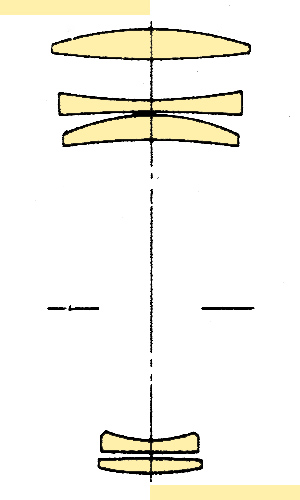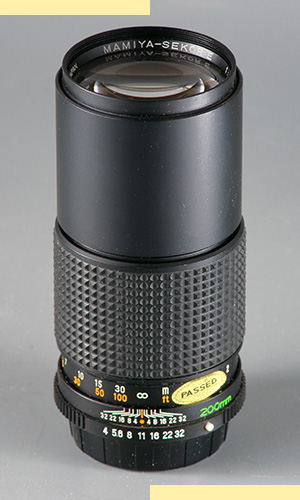The Mamyia Sekor E 4/200mm lens is a medium-long telephoto lens made for the Mamiya Z series SLR. It was introduced around 1982 with the "second wave" of additional five lenses, complementing the original seven Sekor E lenses released in 1979 together with the Mamiya ZE. The E 4/200mm is a well made and pretty good 200mm lens. At only 400 g it is quite lightweight, even though the entire barrel including the focusing ring is made from metal. Mamiya wisely chose not to make it too short, thus facilitating the color correction of the E 4/200mm.The opical construction is typical for 200mm lenses of its time − a triplet master lens in front, and a small doublet at the rear acting as field flattener, improving color correction and reducing the length of the lens (i. e. acting as a small tele converter). Many other lenses including the Konica AR 4/200mm, the Minolta 4.5/200, 4/200mm, 2.8/200mm as well as Canons 2.8/200 and Nikons 2.8/180 ED were built along the same lines.
I bough my first sample of the lens in 1984, and I was always impressed with its detail resolution at f4, especially in dim light and with light sources in the image. I remember well taking images of our village from a distance of 2 km / 1 mile and later on being able to see the small details (such as crossbars on the windows) on the Kodachrome 25 slides. A few years later I gave away all my Mamyia equipment, replacing it with Minolta AF gear. Of course the Minolta AF 2.8/200mm APO was even more intriguing, but the small Sekor E 4/200 always had a special place in my heart.
The lens has a MFD of 2.0m, and it performs really well even at f4, although there are some remaining CAs. Corner performance is very good at f4. The lens preformance is pretty comparable to the best contemporary 4/200mm lenses (e. g. the first computation of the Minolta MC/MD 4/200mm and the Nikkor Ai/AiS 4/200mm). It outperfoms e. g. the Konica AR Hexanon 4/200mm which has more CAs, and most of the earlier 200mm lenses from the 1960s.
Interestingly, Mamiya chose not to re-vamp its 3.5/200mm [4/4] construction which had been available both as Sekor SX as well as Sekor CS. The 3.5/200mm simply wasn't up to date any more; its MFD of 2.5 m as well as the rather low contrast and strong purple fringing may have been acceptable on b/w film, but around 1980 b/w was a thing of the past.
The Sekor E 4/200mm isn't as rare as some other Sekor E primes. Mine has SN just below 12000, indicating that at least 2000 samples had been made in spite of the short production interval. Prices are in the CHF / EUR / USD 50.-- range - twice as much as the earlier Sekor CS 3.5/200mm, and often more expensive than the (equally good but heavy) Sekor E Zoom 3.8/80-200mm.
 |
MAMIYA SEKOR E 200mm 1:4 (5 lenses / 5 elements)
|


